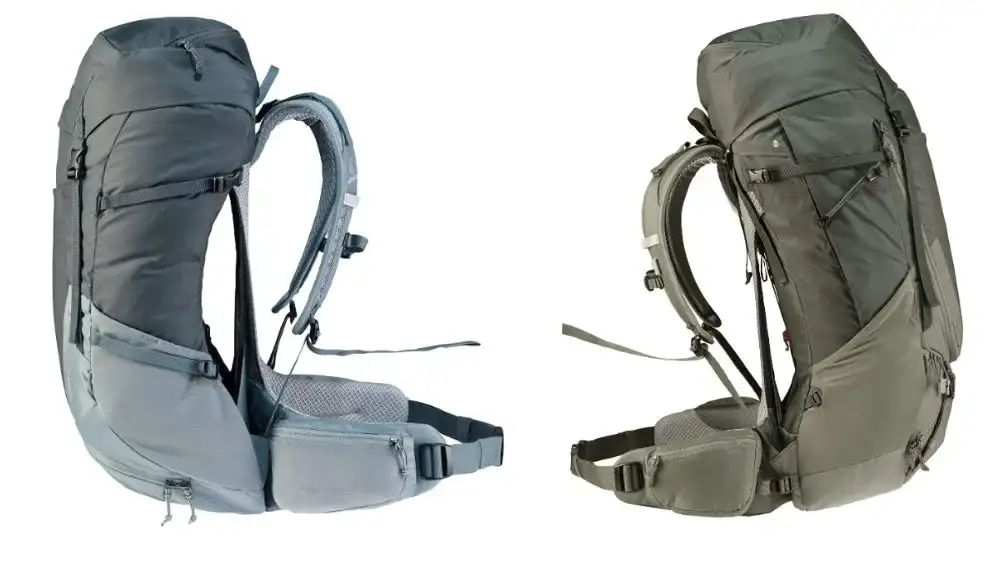If you have a weird gap between back and backpack, no worry, most likely this means you have one of those great ventilated packs that are available on the market.
Hiking and backpacking backpacks are quite generally built by following these two basic concepts:
- There is a tensioned mesh that is in contact with your back, while the backpack is actually detached from your back.
- The backpack is close to the body, and its back panel is in contact with your back.
Both concepts have their pros and cons.

Ventilated packs with a gap between the body and backpack
This is related to the concept 1 mentioned above. This design was launched by Deuter several decades ago in its Futura series. I got my first pack of this type in 2003 and I have been using these backpacks ever since.
The top picture above shows Deuter Futura 32 pack on the left, and Deuter Futura Air Trek 60+10 pack on the right. If you are curious about the number +10 in the name of the latter, this is explained in my separate text.
This design was available for decades only in Deuter packs. But in he past several years, other big brands (Osprey and Gregory) started introducing this design in their packs. This topic I have discussed also in my separate texts about packs that make you sweating less.
As a direct answer to the question in the title, the gap is there on purpose so that you have air circulation in all directions between your back and the backpack. With this you sweat less, and equally important, your back also dries faster.
In other words, this is a ventilated backpack design, something that I use, and there is no way I would ever stop doing this. The same design is in their Deuter Futura Pro packs available on Amazon and Deuter.
Is there any disadvantage of this ventilated backpack design?
Here is how to answer this question. Most likely you know that it is advised to have the heaviest items in your backpack closer to your body.
This is why all packs have the water bladder compartment on the side of the pack that is closest to your back. Typically, water is the heaviest stuff you have in the pack.
There are some downsides of this, and the simple sketches below describe how this all works.

So the pictures shows the following (a bit exaggerated) situations:
• In the case 1 on the left, the center of gravity when you are without a pack is somewhere on a line that goes through the central vertical area of your body.
• When you use a pack, this center of gravity is shifted in the direction of the pack. In the case of a pack designed to stay close to your body (the concept 2 mentioned above), the case 2 (in the middle) shows the center of gravity.
So your pack effectively pulls you back. This is why you have to lean forward to compensate for this. The result is fatigue of course.
• The case 3 on the right is the case of a ventilated pack with that gap. Here, the space behind the back, where you are supposed to have the heaviest items in your pack, is “eaten” with the ventilation gap.
This means that the center of gravity is shifted even farther backward, and you have to lean forward a bit more to make a proper weight balance.
From that last situation you can understand why many people are against this ventilated design. They claim this is bad for stability. But you also have to use your muscles and spend energy in order to balance the weight.
In the case of very heavy packs, it may indeed be better to have the load closer to your body. Of course, you will be sweating more, but your load will likely be more stable. For smaller packs, this is not so important, so it is great to have a ventilated design.
So which concept is better?
I do not think anybody can provide an answer in somebody’s name. Claiming that one is better than the other makes no sense. It is essential to try and you will get some idea of what works best for you.
I know for sure what works for me, but this does not mean you will feel the same. If you are concerned about load stability and not sure in general, you might want to go for the ventilated design only with a smaller pack.
What do you think? Let us know if you have tried these two designs, there is a comment box below.
You might want to read also my text about ways to attach a sleeping bag to a daypack. Thank you for reading and have a nice day.
Leave a Reply